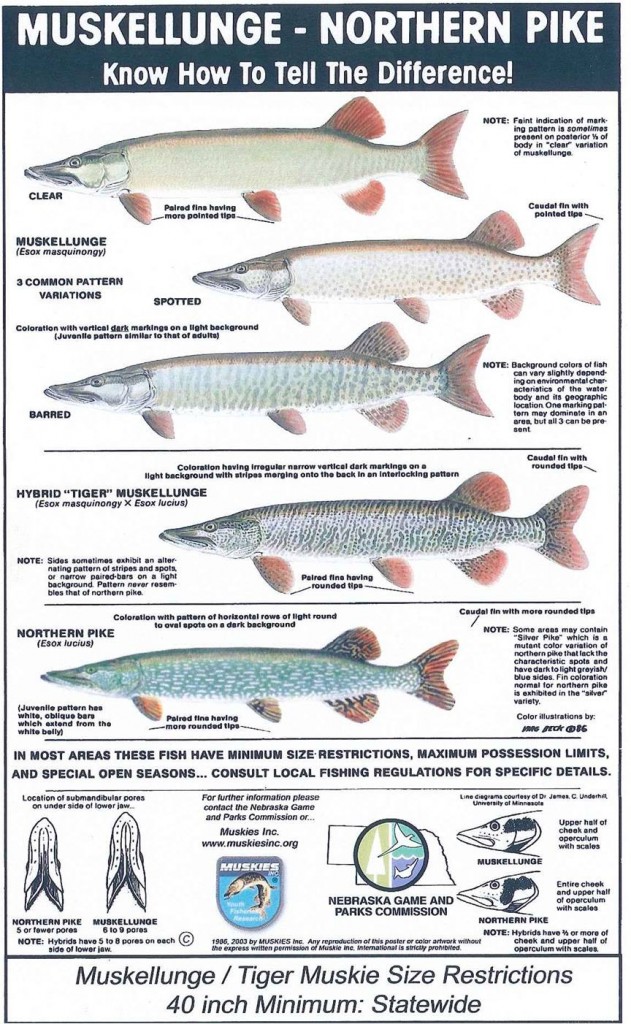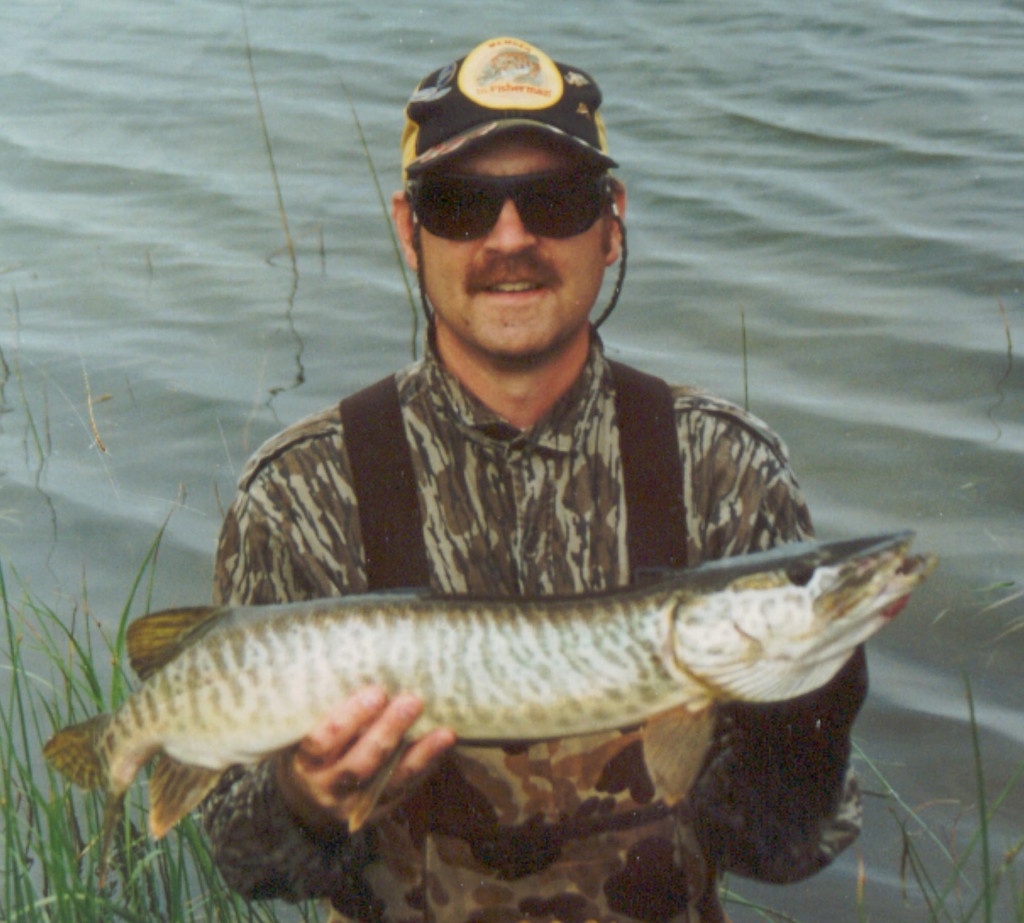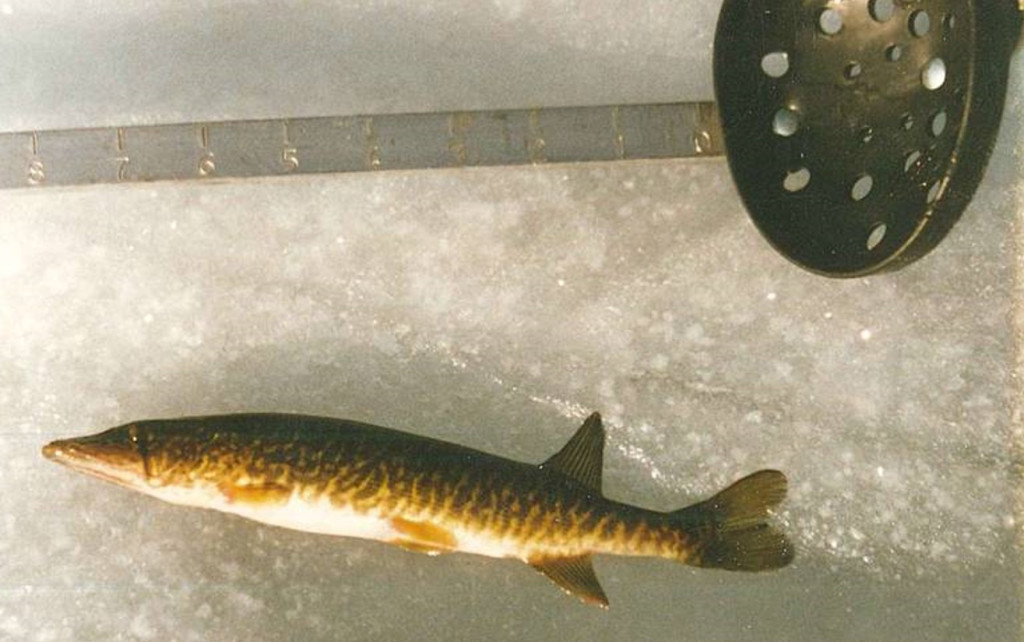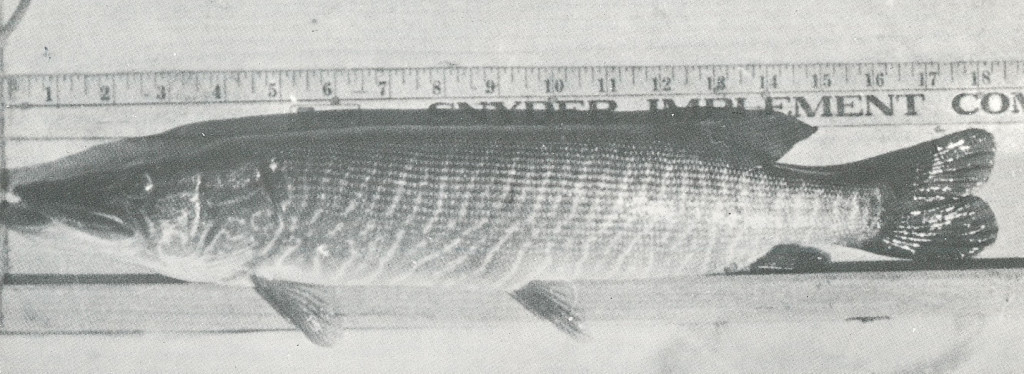By Daryl Bauer
I have posted a series of blogs on hybrid fish. Hopefully, those have increased awareness of these fish in our waters and provided some tips on fish identification. Want to return to that series today. . . .
First, let me define some terms. If you looked at the title, I used a pointy-headed term, the family name for the pike family, esocids. Members of the pike family found in Nebraska would be grass pickerel (specifically a subspecies of redfin pickerel), northern pike and muskellunge. Yes, hybrids do occur between some of those species.
Next, let me give my “speech” on northern pike. . . . They are called “northern” for a reason. All members of the pike family are coolwater fish. That is particularly true for northern pike which have a circumpolar distribution around the globe. It is believed that the native range of northern pike extended only as far south as northern Nebraska. Nebraska is a land of transition, and the farther south you go, the less waters are capable of supporting northern pike. We have documented die-offs of northern pike in southeast Nebraska simply because the water was too warm for them in the summer.
Grass pickerel are also native to Nebraska, mostly northern Nebraska. However, at times grass pickerel have been documented south and east in the lower Elkhorn and Platte river basins.
Muskellunge are also a coolwater fish, but actually are more tolerant of warm water than northern pike. The native range of muskellunge extended south down into Kentucky and Tennessee. Muskellunge were not native to Nebraska, but they have been present in the state for well over sixty years. Muskellunge were first introduced in Nebraska at Lake Minatare in 1958. The first stockings in Merritt Reservoir occurred when that reservoir was new back in 1964.
Tiger muskie are hybrids. They are a hybrid of northern pike and muskellunge. Coloration of muskies can be quite variable and many times pure-bred muskies are mistakenly called “tiger” muskies. Just because a muskie has stripes does NOT mean it is a tiger muskie.
I am not going to post a mashup photo of muskellunge, northern pike and their hybrid, tiger muskie. Nope, not going to because Muskies Inc. has already produced an excellent visual aid for the identification of those fish:

Again, when identifying hybrid fish look for a combination of characteristics of the parent species, or characteristics intermediate between the parent species. As the poster shows, coloration is a big part of tiger muskie identification, but always remember that coloration can vary. Make sure to look at other characteristics! For tiger muskies, especially notice the shape of the tail fin, number of pores on the bottom of the lower jaw, and scale pattern on the “cheek”.
Muskellunge and northern pike can hybridize on their own. I have seen a handful of photos of suspected tiger muskies in Nebraska waters that likely would have been products of hybridization in the wild. In spite of that, by far, most tiger muskies in Nebraska waters have been stocked. Therefore, if you want one clue that tiger muskies might be present, look at stocking records. Be that as it may, fish move around. Our rod & reel state record tiger muskie was caught from Johnson Reservoir in 2001. Tiger muskie have never been stocked in Johnson, but there were fish stocked upstream from there that moved downstream. Just recently saw photos of a tiger muskie caught from McConaughy and again that fish almost assuredly was one that had moved downstream.
Most muskie stocking in Nebraska since 1997 has been pure-bred muskellunge. But, in recent years some tiger muskie stockings have occurred in a few waters. Again, check the stocking database for those waters.
It has been a few years, but I managed to dry off a few Nebraska tiger muskies years ago:

Grass pickerel are by far the smallest member of the pike family in Nebraska. They can be found in sandhills waters, especially the Niobrara and Elkhorn river drainages. Our rod & reel state record grass pickerel was a whopping 10 ounce fish caught from a Holt County borrow pit back in 2016. Despite their small size, grass pickerel are every bit the predator of their larger cousins, pike and muskellunge.
I can remember exploring Elkhorn River backwaters with my Gramps Roth and finding what I thought were little pike sitting in flooded weeds and brush. They would readily attack a live minnow. Looking back I suspect they likely were little pike, but not northern pike. I suspect they were grass pickerel.
Anywho, one picture I have of a grass pickerel was one I pulled through an ice hole. It ate a teardrop and waxworm:

Grass pickerel identification is simple: Look for a small pike with a teardrop below its eye.
Hybridization of grass pickerel and northern pike does occur. Indeed, I believe the first place it was ever documented was in the Nebraska sandhills. D. Bruce McCarraher was a Nebraska fisheries researcher who documented grass pickerel X northern pike hybrids back in 1960. The only photo of a grass pickerel X northern pike hybrid that I could think of was a black and white photo that appeared in one of McCarraher’s publications:

There is no official Nebraska “pike slam”, but if you want a challenge, catching at least one northern pike, muskellunge, tiger muskie and grass pickerel from Nebraska waters would be a worthy quest. If you can throw in a grass pickerel X northern pike hybrid, you would have really accomplished something!
I cannot blog about our big toothy predators without a reminder about careful handling when catching and releasing these fish! The grass pickerel are small enough that they are no problem to handle. On the other hand, I believe anyone fishing waters where pike and muskie are a potential catch, even if you are not targeting those fish, should be prepared to land, handle and quickly release them. Use leaders! Steel, titanium or heavy fluorocarbon leaders are a must! Not only will that allow you to land what could be a fish of a lifetime, it will also keep that fish from swimming away with one of your baits pinning its jaws shut. Then, some tools and a plan are a “must” for handling and releasing these large, toothsome predators.
